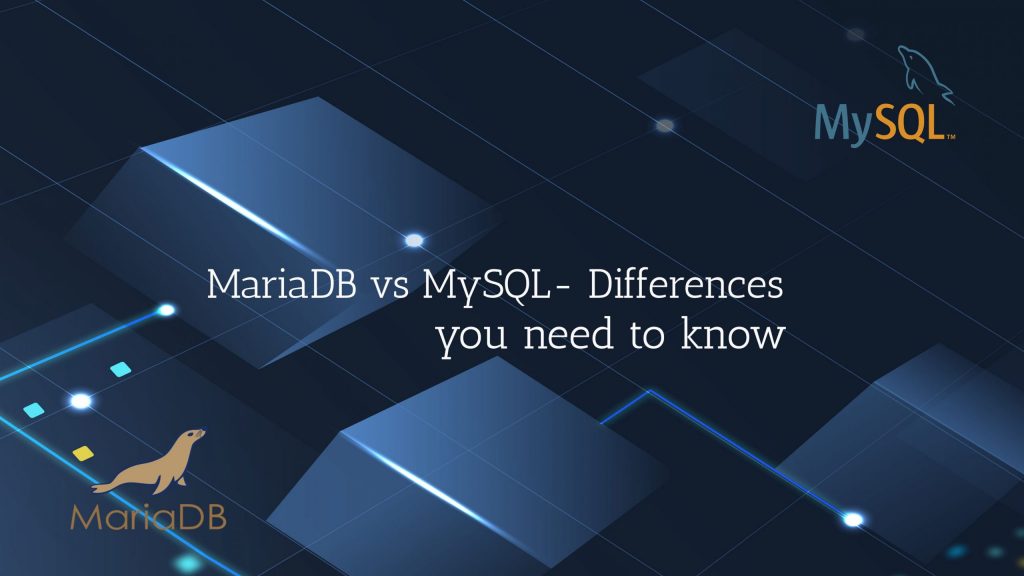
Create directory & set permission using a single Linux command
We will see the major difference between the popular and extensively used database MariaDB vs MySQL. We know that MariaDB’s fork was introduced to secure future access to MySQL and its further development. Here we will see the main difference that you need to consider before opting for one.
Before diving into each feature let’s see the key differences:
- MySQL uses some proprietary code in its Enterprise Edition owned and distributed by Oracle, whereas MariaDB is open-source.
- MariaDB is faster when compared to MySQL with 12 new storage engines than MySQL.
- MySQL supports Data Masking and Dynamic column, while MariaDB doesn’t.
- MariaDB is fully licensed under GPL, whereas MySQL is available under GPL or proprietary license.
Other than these, there is few more difference, so let’s get into details; this will help you choose the better option based on your need.
Main Difference:
Main Difference
Platform Supported
MariaDB and MySQL are available as a service on all three platforms of Amazon Web Services (AWS), Microsoft Azure, and Rackspace Cloud. Also, as a managed service, Google Cloud’s platform is available in MySQL.
Language’s Used
Programming languages like Python, PHP, C, C++, Java, JavaScript, D, Ruby, Pearl are all supported in MariaDB.
MySQL supports Node.js, C, C++, Python, Java, Go, R, D, Perl, Delphi, .NET, Lisp, Erlanger programming languages.
Licensing
Both tools are a free source, however, their license schemes differ slightly: MariaDB follows the GPL License version 2, which is completely covered by the public license, but MySQL employs a more intricate licensing process.
Performance Improvement
When it comes to performance MariaDB perfectly replaces MySQL with a GPL license and offers better performance than MySQL. Even in replication, MariaDB outperforms MySQL.
Storage Engine
MariaDB supports more powerful storage engines than MySQL. Additionally, you will get 12 new storage engines with MariaDB and Binary Packages are included.
For example: XtraDB, Aria, MariaDB ColumnStore, etc. MySQL’s default storage engine is InnoDB, although you can manually install plug-in storage engines for more flexibility.
Command-Line Access
The command-line editors for both of these RDBMSs were generally very similar. However, due to the implementation of the X Protocol in MySQL, they are no longer directly compatible with each other. You can interact with the document storage as well as a script in JavaScript and Python in the MySQL editor.
Users of MariaDB will need to utilize the MariaDB command-line editor that supports basic database operations.
Faster Caching
The Memory storage engine in MariaDB is faster up to 24% for INSERT Command than in MySQL.
Thread Pool
MariaDB has a thread pool technique as a standard feature, which allows it to manage up to 200,000 simultaneous connections, this does not exist in MySQL, but its enterprise edition can only replicate this number.
Forks
The forks of MariaDB is 868, and for MySql it is 1.6K.
Best suited for Enterprise – MariaDB vs MySQL
When you want to opt for an enterprise, the license, and cost matter. MySQL is not ideally suitable for large-sized data, as it triggers a high load on the database server.
MariaDB can be integrated with other relational database management systems. This Open-source software is based on the MySQL Community Version and offers backward compatibility. MariaDB is not free and there is no guarantee of further version updates coming.
So if you’re looking to build commercial applications then, the MySQL enterprise version contains some premium features that are available for free.
MariaDB and MySQL both offer premium support to enterprise users, so you can get support directly from Oracle if needed, if you opt for MySQL and for MariaDB, you can get support from the people who built the latest version.
So anyways you will get a fast and reliable pillar for your LAMP stack that helps you build scalable services for your customers.
Hope this was informative for you to decide which one best suite’s your need. If you need any consultation or assistance we are here to guide you.
You can also check: 7 Ways to Optimize High-Traffic in MySQL
To get more updates you can follow us on Facebook, Twitter, LinkedIn
Subscribe to get free blog content to your Inbox
-
Previous Post
Backup & Restore from VestaCP
-
Next Post
Fix EasyApache YUM Failed Error




